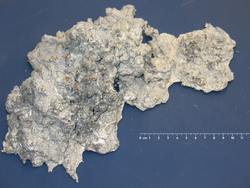
Dross is a mass of solid impurities floating on a molten metal or dispersed in the metal, such as in wrought iron. It forms on the surface of low-melting-point metals such as tin, lead, zinc or aluminium or alloys by oxidation of the metal. For higher melting point metals and alloys such as steel and silver, oxidized impurities melt and float making them easy to pour off.
Contents
With wrought iron, hammering and later rolling remove some dross. [1] With tin and lead the dross can be removed by adding sodium hydroxide pellets, which dissolve the oxides and form a slag. If floating, dross can also be skimmed off.
Dross, as a solid, is distinguished from slag, which is a liquid. Dross product is not entirely waste material; for example, aluminium dross can be recycled and is also used in secondary steelmaking for slag deoxidation. [2]